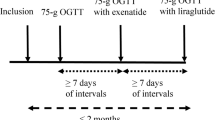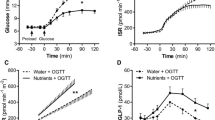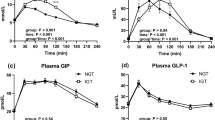Summary
An early defect in subjects with non-insulin-dependent diabetes mellitus (NIDDM) and the preceding phase of impaired glucose tolerance (IGT) is a reduction in early insulin release and hence a prolonged elevation of postprandial blood glucose. We therefore assessed whether a rapidly acting sulphonylurea (glipizide 5 mg 0.5 h before a test meal) could correct these disturbances in 38 IGT/NIDDM subjects, whose early insulin release and postprandial blood glucose elevations remained unimproved after 10 weeks of dietary regulation.
We also assessed whether the efficacy of glipizide was dependent upon the ambient blood glucose concentration, and if early systemic availability of the drug was important for the blood glucose lowering effect.
A single dose of glipizide normalized early insulin release and hence reduced the postprandial blood glucose increase that was not lowered by dietary regulation.
The efficacy of glipizide was dependent upon the early systemic availability of the drug, but early systemic availability and efficacy were independent of the extent of blood glucose elevation, at least within a range of 6–12 mmol·l−1 of fasting blood glucose.
Similar content being viewed by others
References
Seltzer HS, Allen EW, Herron AL Jr, Brennan MT (1967) Insulin secretion in response to glycemic stimulus: Relation of delayed initial release to carbohydrate intolerance in mild diabetes mellitus. J Clin Invest 46: 323–335
Kosaka K, Hagura R, Kuzuya T (1977) Insulin response in equivocal and definite diabetes, with special reference to subjects who had mild glucose intolerance but later developed definite diabetes. Diabetes 26: 944–952
Luft R, Wajngot A, Efendic S (1981) On the pathogenesis of maturity-onset diabetes. Diabetes Care 4: 58–63
Wood FC Jr, Biermann EL (1986) Is diet the cornerstone in management of diabetes? N Engl J Med 315: 1224–1227
Vitzén P-O, Melander A, Scherstén B, Svensson M (1988) Efficacy of dietary regulation in primary health care patients with screening-detected hyperglycaemia. Diabetic Medicine (in press)
Wåhlin-Boll E, Melander A, Sartor G, Scherstén B (1980) Influence of food intake on the absorption and effects of glipizide in diabetic and in healthy subjects. Eur J Clin Pharmacol 18: 279–283
Bitzén P-O, Scherstén B (1986) Assessment of laboratory methods for detection of unsuspected diabetes in primary health care. Scand J Prim Health Care 4: 85–95
Schmidt FH (1961) Die enzymatische Bestimmung von Glucose und Fructose nebeneinander. Klin Wochenschr 39: 1244–1247
Heding LG (1966) A simplified insulin radioimmunoassay method. In: Donato L, Milhaud G, Sirchis J (eds) Labelled proteins in tracer studies. Euratom, Brussels, pp 345–350
Heding LG (1975) Radioimmunological determination of human C-peptide in serum. Diabetologia 1975; 11: 541–548
Wåhlin-Boll E, Melander A (1979) High performance liquid chromatographic determination of glipizide and some other sulfonylurea drugs in serum. J Chromatogr 164: 541–546
Wåhlin-Boll E, Almér L-O, Melander A (1982) Bioavailability, pharmacokinetics and effects of glipizide in type 2 diabetics. Clin Pharmacokinet 7: 363–372
Turtle JR (1970) Glucose and insulin secretory response patterns following diet and tolazamide therapy in diabetes. Br Med J 3: 606–610
Sartor G, Melander A, Scherstén B, Wåhlin-Boll E (1980) Serum glibenclamide in diabetic patients, and influence of food on the kinetics and effects of glibenclamide. Diabetologia 18: 17–22
Widström A, Cerasi E (1973) On the action of tolbutamide in normal man. Acta Endocrinol 72: 519–531
Cerasi E, Efendic S, Thornqvist C, Luft R (1979) Effect of two sulphonylureas on the dose kinetics of glucose-induced insulin release in normal and diabetic subjects. Acta Endocrinol 91: 282–293
Groop L, Luzi L, Melander A, Groop P-H, Ratheiser K, Simonson DC, DeFronzo R (1987) Different effects of glyburide and glipizide on insulin secretion and hepatic glucose production in normal and NIDDM subjects. Diabetes 36: 1320–1328
Melander A, Wåhlin-Boll E (1983) Clinical pharmacology of glipizide. Am J Med 75 (Suppl Nov 30): 41–45
Author information
Authors and Affiliations
Rights and permissions
About this article
Cite this article
Bitzén, P.O., Melander, A., Scherstén, B. et al. The influence of glipizide on early insulin release and glucose disposal before and after dietary regulation in diabetic patients with different degrees of hyperglycaemia. Eur J Clin Pharmacol 35, 31–37 (1988). https://doi.org/10.1007/BF00555504
Issue Date:
DOI: https://doi.org/10.1007/BF00555504




